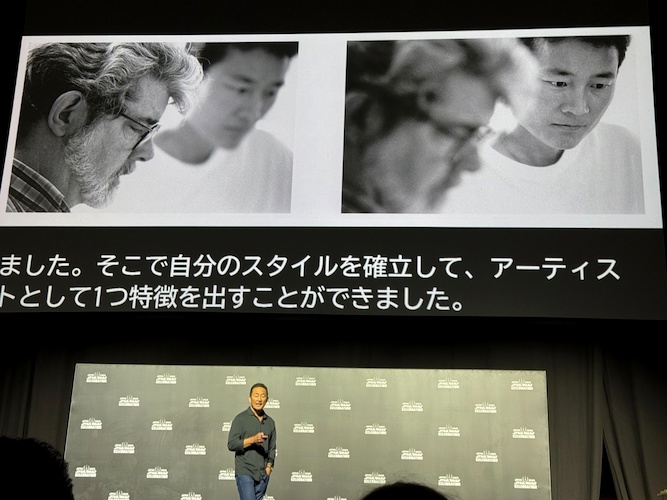Doug Chiang’s Masterclass at Star Wars Celebration Japan: A Journey Through Art, Discipline, and the Star Wars Design Ethos
At Star Wars Celebration Japan, Doug Chiang, the legendary Executive Creative Director for Lucasfilm, offered an intimate and inspiring masterclass titled “Working in the Star Wars Art Department." What followed was not a typical design talk, but a candid, personal journey through the challenges, discipline, and philosophies that shaped his career and the look of Star Wars as we know it.
Chiang opened with refreshing honesty. “Working as an artist in the film industry is tough," he admitted. “It’s not glamorous. Your work will often go unnoticed… But it’s also incredibly rewarding and fulfilling when you’re working with the right people on the right projects." His goal wasn’t to sugarcoat the path - it was to demystify it. With humor and humility, he guided the audience through what it really takes to succeed: grit, consistency, humility, and an endless hunger for improvement.
Chiang shared insights into how design integrates into storytelling on Star Wars projects. “There’s rarely a script at the start," he explained. “Art functions almost like a writer." Early designs, often based on a single sentence or concept, help shape the narrative itself.
He outlined the two phases of design: pre-production, where ideas are bold and unconstrained, and production design, where reality (budget, schedule, logistics) trims them down. “Start big," he urged. “It’s better to cut a diamond than polish crap."
One of the most valuable portions of the panel was Chiang’s emphasis on personal development. He encouraged aspiring artists to maintain daily sketching routines. He begins each day with pencil and ballpoint pen drawings in 3x5 sketchbooks. “Smaller pages are less intimidating," he said. “Even a small sketch is better than nothing."
He emphasized that you don’t need to be the most talented artist, just one who works consistently and thoughtfully. When he joined ILM in 1989, Chiang considered himself “the least skilled" in the room. But he made up for it by working nights and weekends on self-assigned projects for a full year, resulting in a portfolio that eventually earned George Lucas’s attention.
Even after landing his dream job, Chiang struggled with impostor syndrome. “Many artists feel that way," he shared. “But I used that insecurity as motivation." During that time, he created five drawings per day just to keep up. “Was it healthy? Probably not. But it worked for me." He noted the importance of constantly learning, especially with evolving tools like Blender, Photoshop, and Unreal. “Tools are just tools," he said. “Ideas are what count."
Doug Chiang also revealed details about his upcoming two-volume book with Abrams Books, which chronicles his 53-year artistic journey. The set includes over 2,300 personal sketches and paintings - most never seen by the public - and covers everything from early student work to designs for The Phantom Menace, The Mandalorian, and beyond. “It’s meant to be a companion piece to Ralph McQuarrie’s Star Wars volumes," he said.
During the Q&A, Doug Chiang responded thoughtfully to a variety of audience questions:
- Revisiting Old Designs: Chiang acknowledged that unused concepts are often cataloged for future reference. “Some of our strongest designs never saw the light of day," he said, crediting Jon Favreau and Dave Filoni for occasionally reviving them - like the reimagined N-1 Starfighter in The Mandalorian.
- The First Idea Might Be the Right One: “Often, the first or second idea is the best," Chiang noted. “Even if we explore other options, we often return to the original concept."
- Staying True to Star Wars Aesthetic: He explained how new designs need to logically evolve from previous work to maintain the series’ continuity. “Star Wars has rules. George always said, ground your designs in history."
- Theme Park vs. Film Design: Designing for experiences like Galactic Starcruiser required additional layers of realism and safety, with real materials and immersive storytelling. “You can’t cheat like you can on film sets," he said.
- Knowing When to Stop Drawing: Chiang encouraged artists to trust their instincts. “If you find yourself noodling endlessly, it’s time to stop. Often, the quick sketches are the strongest."
Doug Chiang’s 10 Golden Rules for Succeeding in Film Art Departments
- Be humble and kind.
- Remove your ego.
- Collaborate, don’t compete.
- Have strong discipline and personal drive.
- Strive for excellence, regardless of the reward.
- Keep learning - make it a lifestyle.
- Take risks and learn from failure.
- Find your voice and master your style.
- Be honest about your skill level.
- Never be complacent - treat every job like your first.
Doug Chiang’s masterclass was less about showcasing his achievements and more about empowering the next generation of artists with transparency, humility, and real tools for growth. “I’m not the most skilled," he said. “But I’m better than I was last year, and that’s enough." His session stood as a tribute not just to his legendary work, but to the idea that persistence, honesty, and curiosity will always trump raw talent in the long run.
Stay tuned right here to Laughing Place for more news coming out of Star Wars Celebration 2025 in Japan, including at our live blog!




